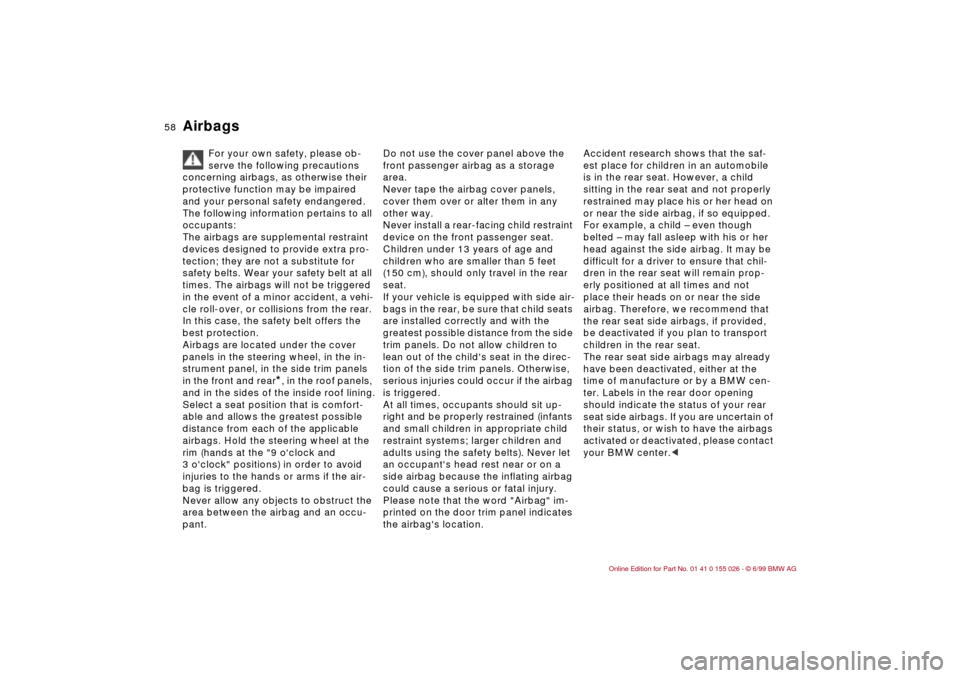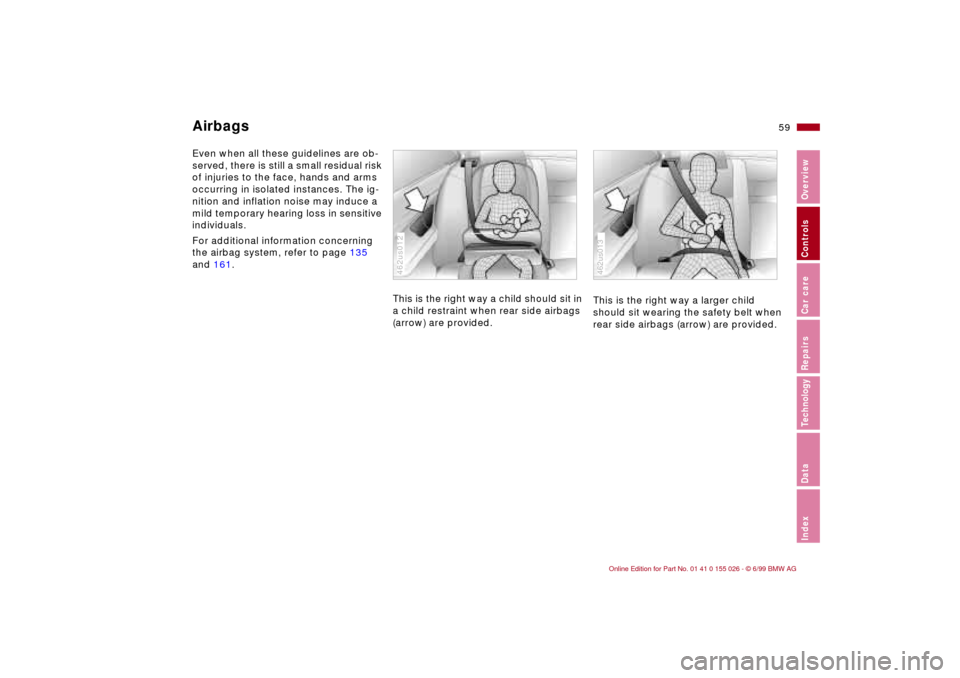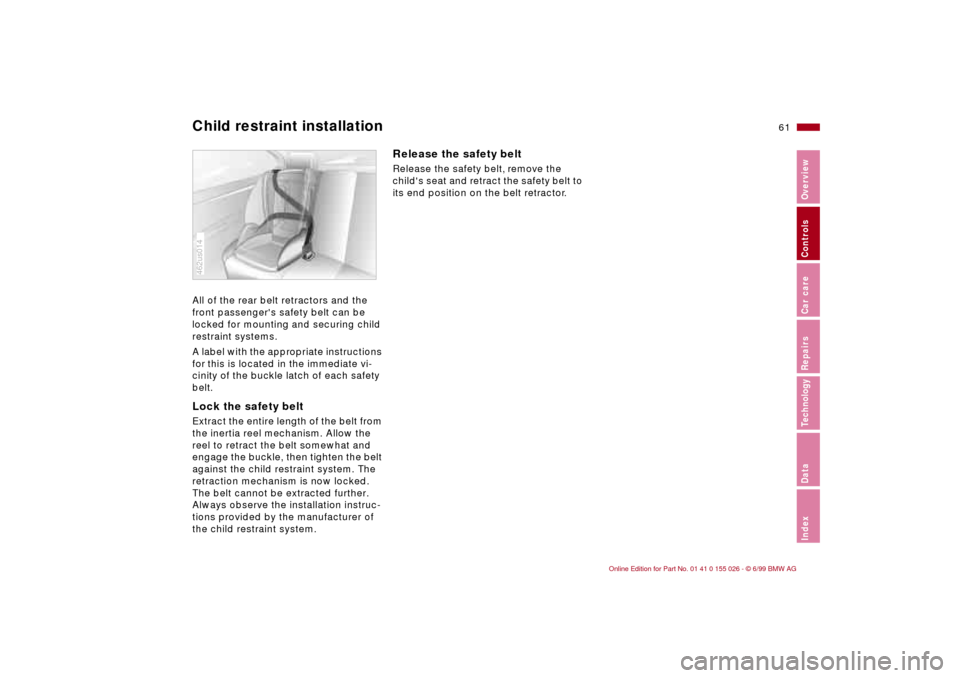2000 BMW 323Ci COUPE child restraint
[x] Cancel search: child restraintPage 12 of 189

Contents
Overview
Controls and features
Cockpit 16
Instrument cluster 18
Indicator and warning lamps 20
Multi-function steering wheel 24
Hazard warning system 25
Warning triangle 25
First-aid kit 25
Refueling 26
Fuel specifications 26
Tire inflation pressure 27
Locks and security systems:
Keys32
Electronic vehicle immobilizer 33
Central locking system 34
Door locks – from outside 34
Using the key 34
Using the remote control 35
Door locks – from inside 38
Luggage compartment lid 39
Luggage compartment 41
Alarm system 42
Electric power windows 44
Sliding/tilt sunroof 45
Adjustments:
Seats47
Seat and mirror memory 50
Steering wheel 51
Mirrors 52
Car Memory, Key Memory 54
Passenger safety systems:
Safety belts55
Child restraint systems 56
Airbags 57
Driving:
Steering/ignition lock 62
Starting the engine 62
Switching off the engine 63
Parking brake 64 Manual transmission
65
Automatic transmission with Steptronic 66
Turn signal/Headlamp flasher 69
Wiper/washer system/Rain sensor 69
Rear window defroster 71
Cruise control 72
Everything under control:
Odometer74
Tachometer 74
Energy control 74
Fuel gauge 75
Temperature gauge 75
Service Interval Display 76
Check Control 77
Clock 77
Onboard computer 77
Technology for safety and
convenience:
Park Distance Control (PDC) 80
Dynamic Stability Control (DSC) 81
Tire Pressure Control (RDC) 82
Page 32 of 189

30n
Locks and security systems:
Keys32
Electronic vehicle
immobilizer33
Central locking system34
Door locks – from outside34
Using the key34
Using the remote control35
Door locks – from inside38
Luggage compartment lid39
Luggage compartment41
Alarm system42
Electric power windows44
Sliding/tilt sunroof45
Adjustments:
Seats47
Seat and mirror memory50
Steering wheel51
Mirrors52
Car Memory, Key Memory54
Passenger safety systems:
Safety belts55
Child restraint systems56
Airbags57
Driving:
Steering/ignition lock62
Starting the engine62
Switching off the engine63
Parking brake64
Page 57 of 189

55n
RepairsIndexOverview Controls Car care Technology Data
Fasten your safety belt before starting
off.
To fasten:
Make sure you hear the catch engage in
the belt buckle.
To release:
Press the red button in the buckle. Hold
the belt and guide it back into its reel.462de205
Safety belt height adjustmentYou can adjust the safety belts to fit your
own physical dimensions by using the
safety belt height adjustment.
Slide the button downward or upward.462de206
In the rear, the belt buckle with the word
"CENTER" is provided exclusively for
the passenger sitting in the middle.
For your safety, please comply with
the following instruction for wear-
ing safety belts. If you do not, the safety
belts may not be able to provide their
maximum protection.
The following information also applies
to your passengers:
Never allow more than one person to
wear a single safety belt. Never allow
infants or small children to ride in a pas-
senger's lap.
Avoid twisting the belt while routing it
firmly across the hips and shoulder. Do
not allow the belt to rest against hard
or fragile objects in your pockets. Never
route the belt across your neck, do not
run it across sharp edges and ensure
that the belt does not become caught
or jammed.
Be sure that the safety belt fits snugly
against your body at all times, and avoid
wearing clothing that prevents the belt
from fitting properly. Pull on the belt pe-
riodically to readjust the tension across
your shoulder. In the event of a frontal
impact, a loose lap belt could slide over
your hips, leading to abdominal injury. In
addition, the safety belt's restraint effec-
tiveness is reduced if the belt is worn
loosely.
Safety belts
Page 58 of 189

56n
Safety belts Child restraint systems
*
Expectant mothers should always wear
the safety belt, taking special care to
position the lap belt over the lower hips,
where it will not exert pressure against
the abdominal area.<
For child restraint system installation,
refer to page 60.
For care instructions, refer to "Caring
for your car" page 133.
If the safety belt system has been
subjected to the stresses involved
in an accident or otherwise damaged:
Replace the entire safety belt mecha-
nism through you BMW center, includ-
ing the safety belt tensioner and any
child restraint systems
* that are in-
stalled. In addition, have your BMW
center inspect the safety belt anchors.<
Never install a rear-facing child
restraint device on the front pas-
senger seat. Injuries could occur if the
airbag is triggered in the event of an
accident.
Children should always ride in the rear.
Do not modify the child restraint system
in any way, or it will not provide your
child with maximum protection.<
Page 60 of 189

58n
Airbags
For your own safety, please ob-
serve the following precautions
concerning airbags, as otherwise their
protective function may be impaired
and your personal safety endangered.
The following information pertains to all
occupants:
The airbags are supplemental restraint
devices designed to provide extra pro-
tection; they are not a substitute for
safety belts. Wear your safety belt at all
times. The airbags will not be triggered
in the event of a minor accident, a vehi-
cle roll-over, or collisions from the rear.
In this case, the safety belt offers the
best protection.
Airbags are located under the cover
panels in the steering wheel, in the in-
strument panel, in the side trim panels
in the front and rear
*, in the roof panels,
and in the sides of the inside roof lining.
Select a seat position that is comfort-
able and allows the greatest possible
distance from each of the applicable
airbags. Hold the steering wheel at the
rim (hands at the "9 o'clock and
3 o'clock" positions) in order to avoid
injuries to the hands or arms if the air-
bag is triggered.
Never allow any objects to obstruct the
area between the airbag and an occu-
pant.
Do not use the cover panel above the
front passenger airbag as a storage
area.
Never tape the airbag cover panels,
cover them over or alter them in any
other way.
Never install a rear-facing child restraint
device on the front passenger seat.
Children under 13 years of age and
children who are smaller than 5 feet
(150 cm), should only travel in the rear
seat.
If your vehicle is equipped with side air-
bags in the rear, be sure that child seats
are installed correctly and with the
greatest possible distance from the side
trim panels. Do not allow children to
lean out of the child's seat in the direc-
tion of the side trim panels. Otherwise,
serious injuries could occur if the airbag
is triggered.
At all times, occupants should sit up-
right and be properly restrained (infants
and small children in appropriate child
restraint systems; larger children and
adults using the safety belts). Never let
an occupant's head rest near or on a
side airbag because the inflating airbag
could cause a serious or fatal injury.
Please note that the word "Airbag" im-
printed on the door trim panel indicates
the airbag's location.Accident research shows that the saf-
est place for children in an automobile
is in the rear seat. However, a child
sitting in the rear seat and not properly
restrained may place his or her head on
or near the side airbag, if so equipped.
For example, a child – even though
belted – may fall asleep with his or her
head against the side airbag. It may be
difficult for a driver to ensure that chil-
dren in the rear seat will remain prop-
erly positioned at all times and not
place their heads on or near the side
airbag. Therefore, we recommend that
the rear seat side airbags, if provided,
be deactivated if you plan to transport
children in the rear seat.
The rear seat side airbags may already
have been deactivated, either at the
time of manufacture or by a BMW cen-
ter. Labels in the rear door opening
should indicate the status of your rear
seat side airbags. If you are uncertain of
their status, or wish to have the airbags
activated or deactivated, please contact
your BMW center.<
Page 61 of 189

59n
RepairsIndexOverview Controls Car care Technology Data
AirbagsEven when all these guidelines are ob-
served, there is still a small residual risk
of injuries to the face, hands and arms
occurring in isolated instances. The ig-
nition and inflation noise may induce a
mild temporary hearing loss in sensitive
individuals.
For additional information concerning
the airbag system, refer to page 135
and 161.
This is the right way a child should sit in
a child restraint when rear side airbags
(arrow) are provided.
462us012
This is the right way a larger child
should sit wearing the safety belt when
rear side airbags (arrow) are provided.462us013
Page 62 of 189

60n
Child restraints
*
All occupants and especially children
should be restrained whenever riding
in a motor vehicle.
Infants or small children should never
be held on the lap of a passenger.
Children should always sit in the rear
and, depending on age, use either a
child restraint system or the existing
safety belts. Accident statistics have
shown that children are safer when
properly restrained in the rear seats
than in the front seating positions.
Infants or toddlers should be secured
with a child restraint system appropri-
ate for their size.
Commercially available child seats
complying with the legal standard are
designed to be secured with a lap belt
or with the lap belt portion of a combi-
nation lap/shoulder belt. 380us123
Improperly or inadequately installed re-
straint systems can increase the risk of
injury to children. Always read and fol-
low the instructions that come with the
system.
If the child restraint of your choice re-
quires the use of a tether strap, three
fastening points (see arrows) have been
provided on the rear shelf for attach-
ment. Ask your BMW center to perform
the necessary work.
Before installing any child restraint
device or child seat, please read
the following:
Never install a rearward-facing child
restraint system in the front passenger
seat of this car.
Your car is equipped with an airbag
supplemental restraint system for the
front passenger. Because the backrest
on any rear-facing child restraint sys-
tem (of the kind designed for infants
under 1 year and 20 lbs.) would be
within the airbag's deployment range,
you should never mount such a device
in the front passenger seat, as the im-
pact of the airbag against the child re-
straint's backrest could lead to serious
or fatal injuries.
If it is necessary for a child (not an
infant) to ride in the front seat, certain
precautions should be taken. First,
move the passenger seat as far away
from the dashboard as possible. This
important precaution is intended to
maximize the distance between the air-
bag and the child. Older children should
be tightly secured with the safety belt.
Younger children should be secured in
an appropriate forward-facing child re-
straint system that has first been prop-
erly secured with a safety belt.
Never install a rear-facing child restraint
system in the front passenger seat.
We strongly urge you to carefully read
and comply with the instructions for in-
stallation and use provided by the child
restraint's manufacturer whenever you
use such a device.
Be sure that all occupants (of all ages)
remain properly and securely restrained
at all times.c
All rear seating positions in your vehicle
meet the recommendations of SAE
J1819, an industry recommended prac-
tice for securing child restraint systems
in motor vehicles.
Page 63 of 189

61n
RepairsIndexOverview Controls Car care Technology Data
Child restraint installationAll of the rear belt retractors and the
front passenger's safety belt can be
locked for mounting and securing child
restraint systems.
A label with the appropriate instructions
for this is located in the immediate vi-
cinity of the buckle latch of each safety
belt.Lock the safety beltExtract the entire length of the belt from
the inertia reel mechanism. Allow the
reel to retract the belt somewhat and
engage the buckle, then tighten the belt
against the child restraint system. The
retraction mechanism is now locked.
The belt cannot be extracted further.
Always observe the installation instruc-
tions provided by the manufacturer of
the child restraint system.462us014
Release the safety beltRelease the safety belt, remove the
child's seat and retract the safety belt to
its end position on the belt retractor.